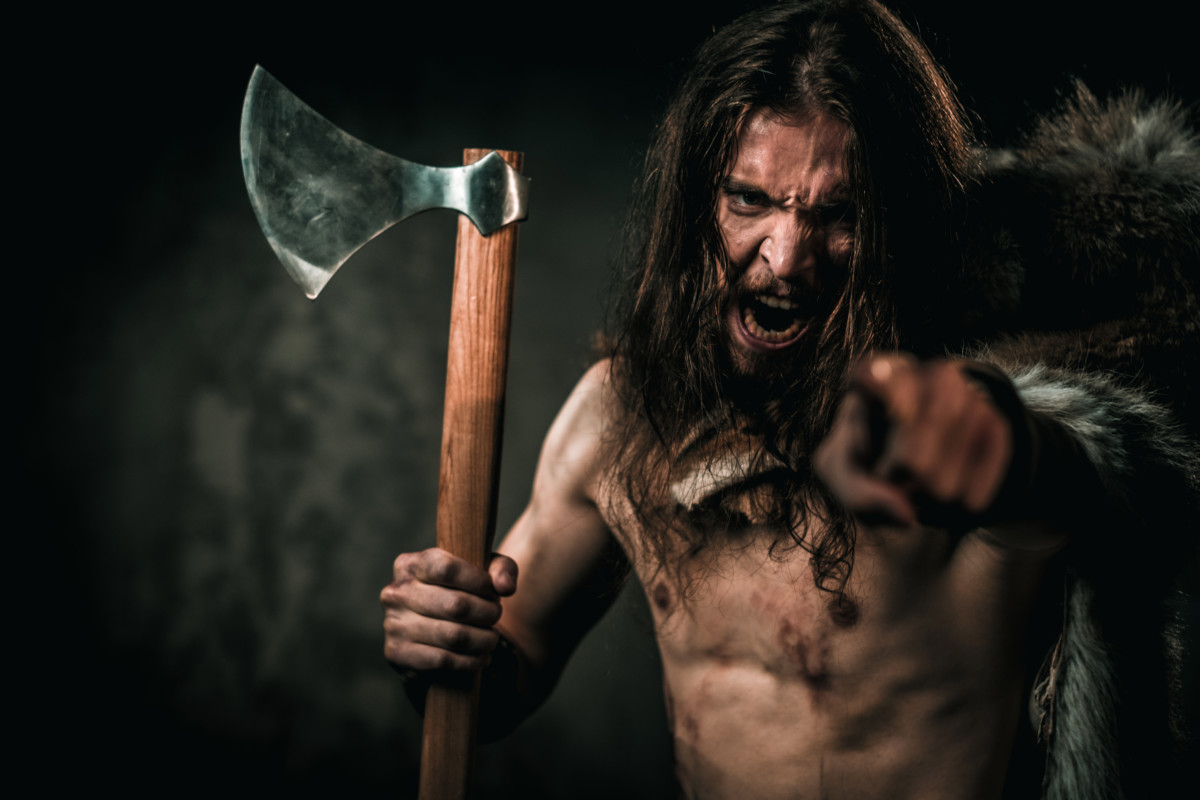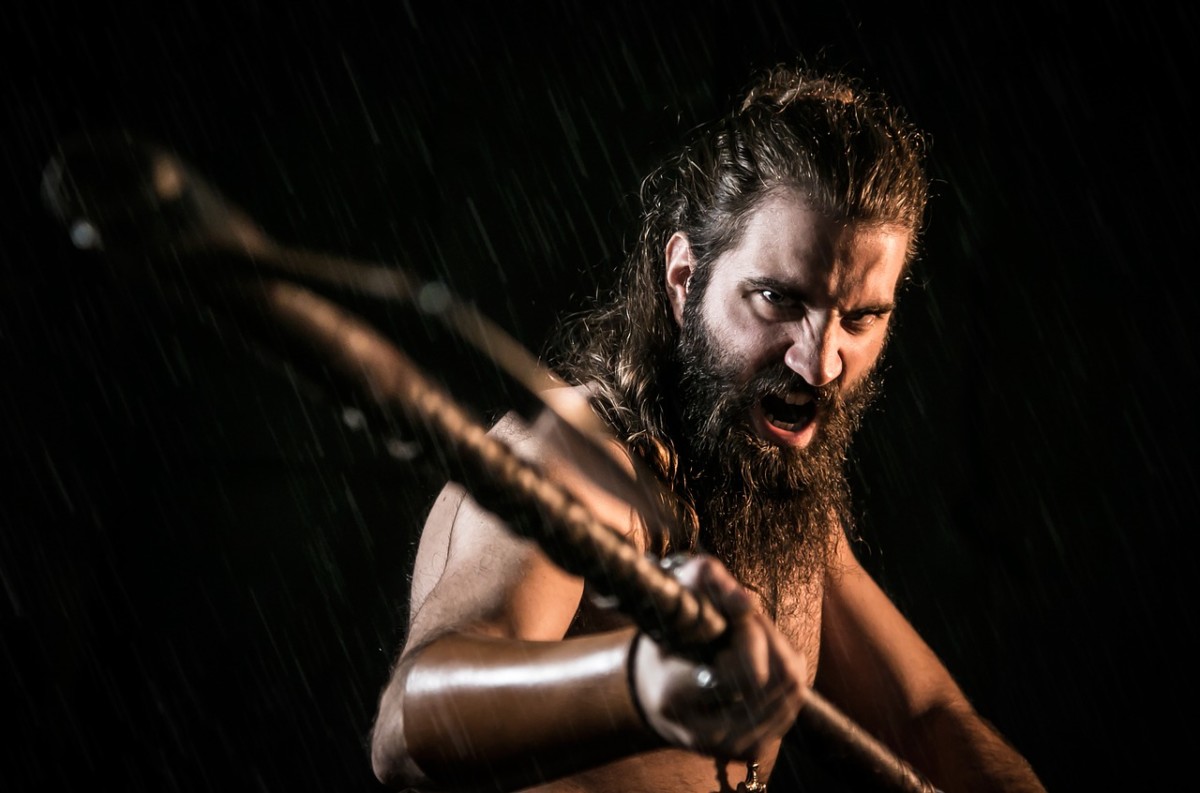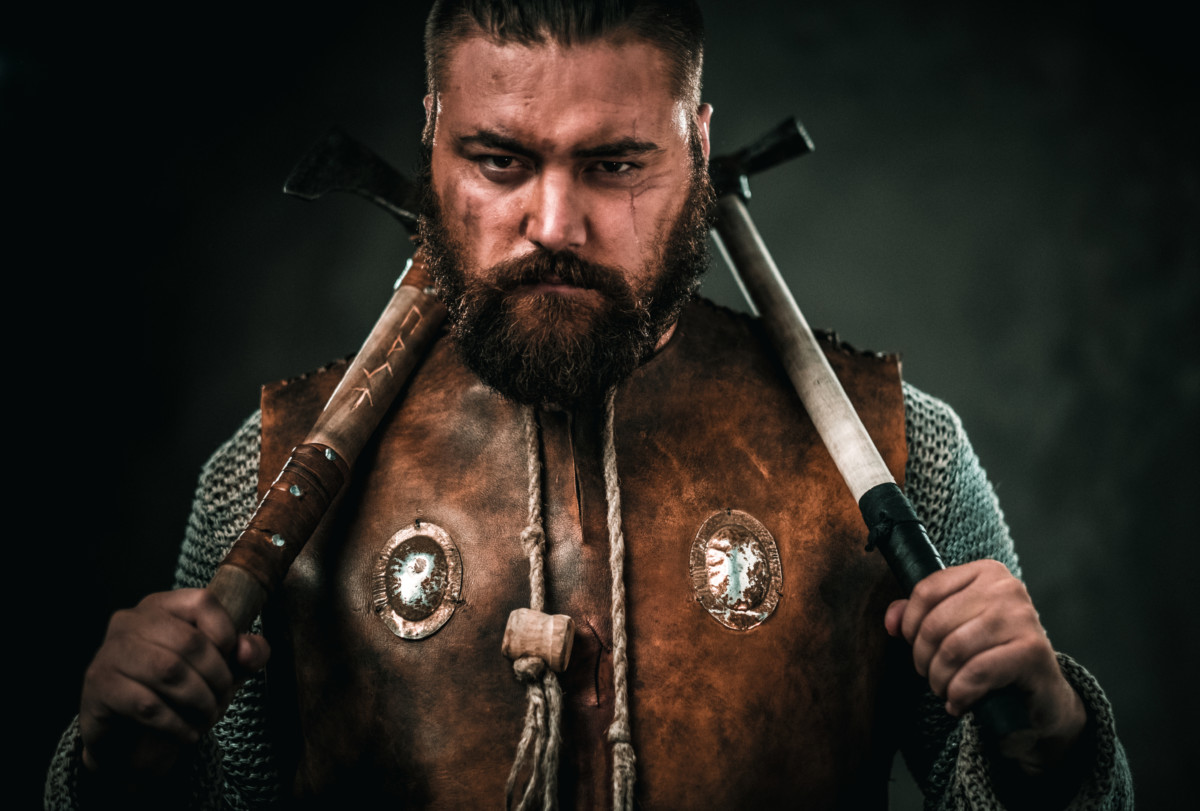Welcome to the world of the Viking Berserker, a fascinating facet of Norse mythology wrapped in strength, fury, and a dash of madness. Delve into this article and immerse yourself in the riveting history of these legendary warriors. Don’t forget to explore our captivating collection of Viking rings and other Gothic merchandise, artfully crafted to reflect the mystic and intricate heritage of the Viking culture.
Unmasking the Berserkers
The term berserker is derived from Old Norse ‘berserkr,’ a compound word combining ‘ber’ (bear) and ‘serkr’ (shirt). The bear, revered for its brute strength and ferociousness, is an apt representation of these warriors who were renowned for their beastly fierceness in battle.
“In the eyes of a berserker, the line between man and beast blurred, cultivating a terrifying figure on the battlefield.“
The Berserker Battle Trance
The Berserkers have been famously depicted as entering a trancelike fury before a battle, a state known as berserkergang. This trance was said to grant them superhuman strength, immunity to pain, and the fearsome ability to instill terror in their enemies. The helm of awe ring in our collection is a vivid depiction of this terrifying power.
In this state, the berserkers were said to gnaw at their shield edges, bellow like wild beasts, and charge into battle with reckless disregard for their own safety, seeming more beast than man. The wolf ring captures this raw animalistic spirit associated with these warriors.
Berserkers in Norse Society
Despite their unpredictable nature, Berserkers played a critical role in Norse society. They were revered as holy warriors with divine favor, their battle frenzy viewed as a form of spiritual possession. While in society they might have been unpredictable and feared, on the battlefield, they were a sight of relief for their allies and a symbol of impending doom for their enemies.
The rune rings available in our collection are etched with the ancient Viking alphabet, each character holding a special significance, a nod to the rich cultural fabric that birthed the Berserkers.
Emblems of Berserkers
Viking berserkers often identified themselves with specific animals, most commonly the bear and the wolf. These animals were symbols of primal strength and ferocity, attributes that the berserkers aimed to embody in their warrior life.
If you want to carry a piece of the berserker legacy with you, check out our animal rings that exhibit the ferocity of these revered creatures. The meticulously crafted dragon rings are a particular favorite, embodying the fearsome creature that is so prevalent in Norse mythology.
“The berserkers wore their spirit animals not just on their bodies, but also in their hearts and souls.“
The Dark Side of the Berserker Legend
As much as they were renowned for their valour and might, the berserkers also carried a darker reputation. Many accounts, especially from Christian writers of the time, portrayed them as chaotic, unruly men who could just as quickly turn their rage towards friends as they would their enemies. They were said to be just as destructive in times of peace as they were in war, causing havoc and disruption in Norse society.
Even in the Viking sagas, berserkers were often depicted as villains or obstacles that the saga’s hero needed to overcome. It is fascinating how these warriors manage to exist as heroes and villains simultaneously, their actions both revered and feared. Their mystique and the dichotomy of their existence is perfectly captured in our skull ring collection.
“The berserker, a figure of strength and fear, a testament to the dual nature of man.“
Berserkers in Modern Culture
In the modern era, berserkers have been the inspiration for various characters and elements in pop culture. From the fantasy genre’s barbarian warriors to berserker-style abilities in video games, their legacy continues to influence creative minds.
Within the realm of fashion, the Viking Berserker has inspired a niche of gothic accessories. Our Viking necklaces pay homage to these powerful warriors and their spiritual journey.
Berserker Jewelry
The tradition of Viking jewelry was as much about its beauty as it was about the symbolism behind the designs. Our Viking bracelet collection aims to recreate that blend of aesthetics and spiritual significance.
Each piece is designed with iconic Norse symbols, such as the Vegvísir compass and the tree of life, which carry the spirit of the Viking Berserker. These symbols were said to offer protection and guidance, vital tools for a warrior who tread the line between man and beast.
“Each piece of jewelry carries a part of the berserker’s soul, a testament to their indomitable spirit.“
Immortalizing the Berserker Legacy
Whether we look at them as rampaging warriors or spiritual devotees, there is no denying the unique place that Viking berserkers hold in history. Their legacy of fearlessness, fury, and spiritual transcendence continues to captivate our imaginations, leaving an indelible mark on history.
The Gothic Merchant aims to keep this legendary legacy alive through its exclusive collection of Viking Berserker jewelry. Explore our stunning range of Valknut jewelry and other Viking-themed accessories to find your own piece of this inspiring and intriguing history.

Unlocking the Berserker Symbols
In the midst of the wild fury and rampage, Viking Berserkers adorned themselves with meaningful symbols that are much more than mere decoration. These symbols held deep spiritual significance, designed to protect and guide warriors on both the physical and spiritual battlegrounds.
Rune Rings
Runic alphabets were used by ancient Germanic tribes, including the Vikings. The symbols, or runes, were believed to have magical properties and were often used for divination and to cast spells. Our collection of rune rings embeds this ancient script into unique designs, allowing you to carry a piece of Viking magic with you.
Helm of Awe
The Helm of Awe, known as Ægishjálmur in Old Norse, is one of the most mysterious and powerful symbols in Norse mythology. Vikings believed that it could instill fear in their enemies and protect them in battle. If you feel a connection with this mighty symbol, explore our Helm of Awe ring collection.
Valknut
The Valknut, a symbol comprising three interlocking triangles, is often associated with the Norse god Odin. It symbolizes the afterlife and has been interpreted as the “knot of those fallen in battle”. As part of our tribute to the Viking Berserkers, we offer a dedicated line of Valknut jewelry.
Tradition Meets Modernity
At The Gothic Merchant, we respect and cherish the age-old craft of jewelry making. Each piece in our collection is a marriage of traditional craftsmanship and modern design. Our Viking earrings and Viking necklaces embody this perfect balance, making them an ideal choice for the modern Viking enthusiast.
“Every piece of jewelry tells a story, every symbol carries a legacy.“
Embrace Your Inner Berserker
Ultimately, the story of the Viking Berserkers serves as a reminder of the fierce power within all of us. The Gothic Merchant is here to help you embrace your inner berserker, with our extensive collection of Viking jewelry.
Whether you’re drawn to the mighty raven, the divine tree of life, or the protective dragon, there’s a piece for everyone in our collection.
Delve into the rich history and spiritual depths of Viking culture with our exquisite collection, and wear your chosen symbols with pride, just as the Viking Berserkers did in their time.
From the depths of history, through the Gothic Merchant, the spirit of the Berserker lives on. Embrace the call, and let the saga continue with you.

Tracing Berserker Origins
To uncover the origins of the first berserkers, we must journey back through time, to ancient historical texts. In his book, “Germania”, the Greek historian Tacitus describes extraordinary elite warriors among the North European German tribes. By the sixth century, the Romanian historian Prokopios spoke of wild, lawless individuals, known as the Heruli, from the North. These fearless warriors fought almost naked, simply adorned with a loincloth – a bold display of their indifference to injury.
They eschewed conventional protective gear like helmets or chain mail, choosing to use only a simple shield. These fearsome individuals are believed to hail from present-day Denmark, with their influence felt throughout other Scandinavian regions, notably Norway. It’s speculated that the Heruli lived until the 6th century in present Denmark. Driven out of Scandinavia by the Danes, many served as warriors in the Roman army. They were much like the berserkers, functioning in small groups, serving a chieftain or king. It’s therefore plausible that the origins of the berserkers lie with these enigmatic Heruli.
At The Gothic Merchant, we celebrate these legends through our line of animal-themed rings, notably wolf rings, and eagle rings, symbolizing the raw courage and strength of these ancient warriors.
Berserkers in Myths and Sagas
The sagas – Icelandic poems composed in the courts of Scandinavian chieftains during the Viking and Middle Ages – frequently mention berserkers. These texts describe these individuals in a Christian context, expanding their memory to encompass anything deviating from the societal norms of that time.
In the wider sense, berserkers were not only warriors but also thugs, buccaneers, and pirates. According to the Grågås, the first collection of Icelandic law, a violent berserker could even be sentenced to exile. The oldest known reference to berserkers comes from a 9th-century Icelandic poem, “Haraldskvadet”, referring to the Battle of Hafrsfjord: “Berserkers roared where a battle raged, pagan wolves howled, iron weapons trembled.”
Their legend continues in the medieval work, the “Grettis saga”, where the berserkers are mentioned in connection with the same battle. In the Volsung saga, a legendary Icelandic tale, the berserkers were Odin’s guards, depicted as “armorless, as mad as dogs or wolves, as strong as bears or oxen.”
“Berserkers, in their raw fury and strength, represent a fascinating facet of our shared history.“
But it’s important to remember that not all violent men and killers described across the sagas were berserkers. The sagas carefully distinguish these men, attributing to them a particular nature, making them despicable and feared by most.
The Gothic Merchant brings you closer to these tales of old with our collection of pirate-themed rings and lion pendants, echoing the raw, unbridled power of the berserkers.
Through our unique, handcrafted pieces, we aim to keep the berserker spirit alive, making it accessible to modern-day warriors.
FAQ
What were the Viking berserkers?
Viking berserkers were fierce warriors who fought with uncontrollable rage and ferocity. They were often associated with Norse mythology and were known for their distinctive fighting style.
Why were berserkers so feared?
Berserkers were feared because of their reputation for entering a state of uncontrollable frenzy during battle. They were known to exhibit extraordinary strength, endurance, and a lack of self-preservation, making them incredibly dangerous opponents.
Were Berserker Vikings real?
Yes, Berserker Vikings were real. Historical accounts and sagas mention the existence of berserkers, describing their unique characteristics and contributions to Viking warfare.
How did a Viking become a berserker?
The exact process of becoming a berserker is not entirely clear. However, it is believed that some Viking warriors would undergo certain rituals, such as invoking the favor of the gods or consuming special herbs, to induce a trance-like state that allowed them to unleash their berserker fury in battle.
Was Ragnar Lothbrok a Berserker?
While Ragnar Lothbrok is a legendary Viking figure, there is no concrete evidence to suggest that he was a berserker specifically. However, he is often depicted as a fierce and formidable warrior.
Who killed the berserkers?
Berserkers were not specifically targeted by any particular group or individual. They were warriors like any other Viking, and their demise would have come at the hands of their enemies on the battlefield.
Who was the most famous berserker?
The most famous berserker mentioned in Norse sagas is said to be Hrolf Kraki, a legendary Danish king known for his exceptional strength and prowess in battle.
Why are berserkers blind?
The idea of berserkers being blind is a myth. While they fought with intense fury and lacked self-preservation, they were not actually physically blind. The myth may have originated from their seemingly reckless and frenzied fighting style.
What are the 3 types of Berserkers?
The three types of berserkers mentioned in Norse sagas are “úlfheðnar” (wolf-coats), “berserkir” (bear-shirts), and “svíþjóð” (Swedes). These names were used to describe different groups of Viking warriors with distinct characteristics and fighting styles.
What weapons did Berserkers use?
Berserkers used a variety of weapons common to Viking warriors, including swords, axes, spears, and shields. They would choose their weapons based on personal preference and the demands of the battle.
What did berserkers eat before battle?
There is no specific information about what berserkers ate before battle. Like other Vikings, their diet would have consisted of meat, fish, grains, and dairy products. They would have consumed a nourishing meal to prepare for the physical demands of combat.
Who is the god of berserkers?
The god associated with berserkers in Norse mythology is Odin, the Allfather. Odin was believed to grant strength and ferocity to warriors, and berserkers were often thought to be under his patronage.
Did berserkers bite their shields?
While biting shields is not specifically mentioned as a common practice among berserkers, it is possible that some warriors resorted to such behaviors in the heat of battle. However, it should be noted that berserkers’ ferocity and fighting style were not solely defined by biting shields.
What did berserkers drink?
Berserkers were known to consume a potent alcoholic beverage called “mjöðr” or “mead” before battle. Mead was associated with Odin and was believed to enhance warriors’ strength and courage.
What religion were berserkers?
Berserkers followed the Norse religion, also known as Norse paganism. They worshiped a pantheon of gods and goddesses, with Odin being particularly revered for his association with war and warriors.
How strong were berserkers?
Berserkers were known for their exceptional strength and ferocity in battle. While the exact extent of their strength is difficult to measure, their reputation as fearsome warriors suggests that they were exceptionally strong compared to their contemporaries.
How was a berserker killed?
Like any other Viking warrior, a berserker could be killed in battle by various means, including weapons, arrows, or other forms of combat. Their lack of self-preservation and reckless fighting style likely made them vulnerable to skilled opponents who could exploit their aggression.
What powers does a berserker have?
Berserkers were believed to possess enhanced strength, endurance, and resistance to pain. In their state of frenzy, they fought with relentless ferocity and displayed exceptional battlefield prowess.

Belladonna crafts bewitching blog posts inspired by Gothic elegance, marrying shadow with style. As a discerning researcher, she curates products that echo whispers of moonlit romance. With a playful twinkle in her eye and a quill always at hand, she invites readers to dance on the line between mystery and enchantment.




0 Comments